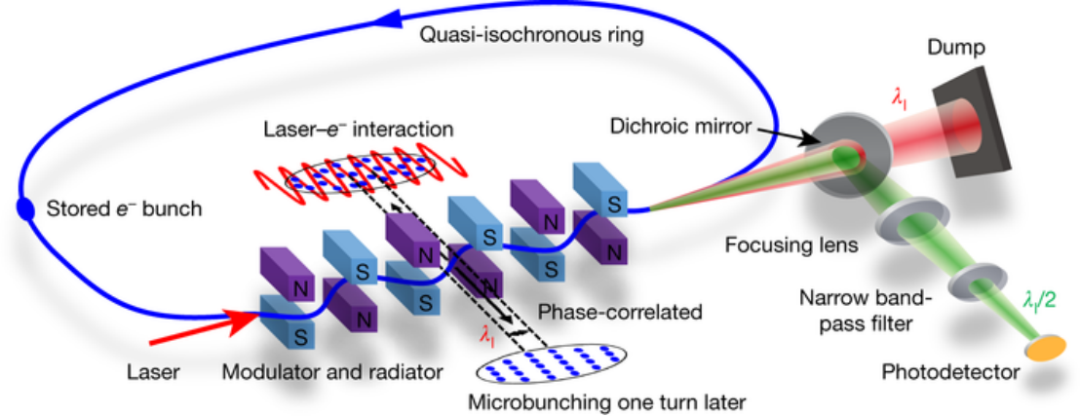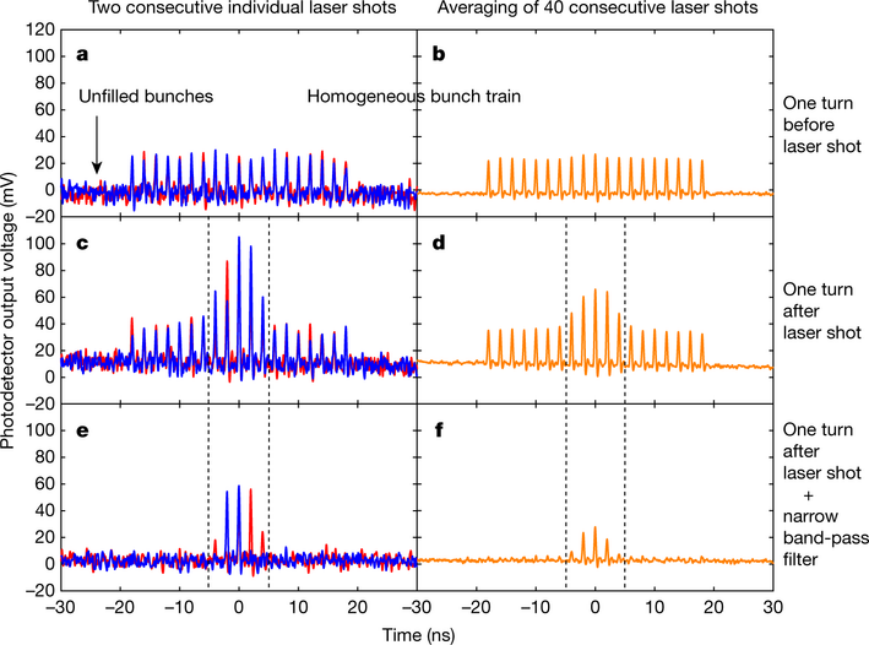Service hotline
+86 0755-83044319
release time:2023-09-15Author source:SlkorBrowse:14865
The light source is a critical breakthrough in EUV lithography technology.
In February of this year, Professor Tang Chuanxiang's research group from the Department of Engineering Physics at Tsinghua University, in collaboration with the Helmholtz-Zentrum Berlin für Materialien und Energie (HZB) and the Physikalisch-Technische Bundesanstalt (PTB) in Germany, published a research paper titled "Experimental demonstration of the mechanism of steady-state microbunching" in the journal Nature.
The paper reports the first experimental validation of a new particle accelerator light source called "Steady-state microbunching" (SSMB). Based on the SSMB principle, it is possible to obtain high power, high repetition rate, and narrow bandwidth coherent radiation that covers wavelengths ranging from terahertz to extreme ultraviolet (EUV). This has the potential to provide broad new opportunities for photon science research.
The reviewers of Nature highly praised this research, stating that it "demonstrates a new methodology" and "will undoubtedly generate interest in the fields of particle accelerators and synchrotron radiation". A related commentary article in Nature stated, "This experiment demonstrates how to combine the characteristics of the two main types of accelerator light sources, synchrotron radiation sources, and free-electron lasers."
The future application of SSMB light sources is expected in fields such as EUV lithography and angle-resolved photoemission spectroscopy. Upon publication, this paper immediately garnered significant attention from the academic and industrial communities domestically and internationally.

In the experiment, the research team used a laser with a wavelength of 1064 nm to manipulate an electron beam in the storage ring MLS located in Berlin. After completing one full revolution around the ring (with a circumference of 48 meters), the electron beam formed a fine microstructure, known as microbunching. Microbunching generates high-intensity, narrow-bandwidth coherent light at the laser wavelength and its harmonics. The formation of microbunching was verified by detecting this radiation.
The formation of microbunching demonstrates that the optical phase of electrons can be correlated with sub-wavelength precision on each revolution, allowing the electrons to be stably trapped in an optical potential well created by the laser. This validates the working mechanism of SSMB. The experimental setup is illustrated in Figure 1, and some of the experimental results are shown in Figure 2.

The concept of SSMB was proposed by Professor Wu Zhao and his doctoral student Daniel Ratner at Stanford University in 2010. Wu Zhao has been continuously promoting research and international cooperation on SSMB. In 2017, Tang Chuanxiang and Wu Zhao initiated the experiment. Tang Chuanxiang's research group led the theoretical analysis and physical design of the experiment, developed the laser system for testing, conducted the experiment with collaborating units, and completed the data analysis and paper writing.
It is expected to provide a new technological pathway for EUV lithography light sources.
One of the potential applications of SSMB light sources is as a light source for future EUV lithography machines, which is why the international community pays great attention to the SSMB research at Tsinghua University.
In the semiconductor manufacturing industry, the lithography machine is an essential precision equipment and the most complex and critical step in the process of integrated circuit chip manufacturing. The resolution of the lithography machine is directly related to the wavelength. For over half a century, the wavelength of the light source for lithography machines has been continuously reduced. The recognized next-generation mainstream lithography technology in the chip industry is EUV lithography with a wavelength of 13.5nm. EUV lithography works by using extreme ultraviolet light with a wavelength only one ten-thousandth the diameter of a hair to "etch" circuits onto wafers, ultimately enabling chips the size of a fingernail to contain billions of transistors. This technological process showcases the cutting-edge level of human technological development. ASML, a company based in the Netherlands, is currently the only supplier of EUV lithography machines, and each machine is priced at over $100 million.
A high-power EUV light source is the cornerstone of EUV lithography machines. Currently, ASML uses high-energy pulsed laser to [敏感词]ard a liquid tin target, creating plasma and generating EUV light with a wavelength of 13.5nm, with a power of about 250 watts. As the chip fabrication nodes continue to shrink, it is expected that the demand for power in EUV light sources will increase, reaching the kilowatt level.
"In short, EUV light required by lithography machines needs to have a short wavelength and high power," said Tang Chuanxiang. The breakthrough of high-power EUV light sources is crucial for further applications and development of EUV lithography. Tang Chuanxiang said, "SSMB-based EUV light sources are expected to achieve high average power and have the potential for wavelength extension to even shorter wavelengths, providing a new solution for the breakthrough of high-power EUV light sources."
There is still a long way to go in the independent development of EUV lithography machines, and SSMB-based EUV light sources are expected to address the most critical bottleneck in the independent development of lithography machines. This requires continuous technological breakthroughs in SSMB EUV light sources and cooperation along the entire industry chain in order to achieve true success.
Collaborative research and development
The SSMB team at Tsinghua University started the theoretical analysis and numerical simulation of SSMB principle verification experiments in April 2017. On July 21st of the same year, Tang Chuanxiang and Zhao Wu organized the first SSMB collaboration meeting at Tsinghua University, leading to the establishment of the international SSMB research group. Researchers from China, Germany, the United States, and other countries joined forces to promote various research projects, including SSMB principle verification experiments. After four years of hard work, the SSMB research group made significant progress and achieved results that are leading the world.
"SSMB uses lasers to focus electrons, which shortens the wavelength of the focusing system by 5 to 6 orders of magnitude compared to the microwave commonly used in synchrotron light sources. Therefore, to verify the principle of SSMB, the accelerator needs to have very high control precision over the longitudinal position (phase) of electrons in each revolution. The MLS storage ring at PTB in Germany is closest to the experimental requirements of SSMB. After initial contacts and communications between our professors, the HZB and PTB institutions in Germany actively joined the research team and collaborated with us," said Deng Xiujie, a doctoral student from the Department of Engineering Physics at Tsinghua University, who participated in the experiments in Germany.
Since 2017, members of the Tsinghua team have visited Berlin eight times, participating in various stages of the experiment preparation and operation. After a long period of effort, the experiment was successful on August 31, 2019. Deng Xiujie said, "SSMB involves multiple physical effects and is technologically challenging. The team experienced several failed attempts before continually deepening their understanding of physical problems and practical accelerator operations during the experiment, until each problem was resolved. When on-site experiments were not possible, we did not stop working. We conducted theoretical analysis on previously collected experimental data, held regular work meetings, and engaged in email or online discussions." "In addition, the SSMB experimental team is an international collaboration team. From the initial adaptation to gradually familiarizing and understanding each other, the whole team believes that we have truly achieved '1+1>>2'. Everyone is confident in further cooperation in the future."
Currently, Tsinghua University is actively supporting and promoting the national project of the SSMB EUV light source. The SSMB research group at Tsinghua has submitted a project proposal for "Steady-State Micro-Bunched Extreme Ultraviolet Light Source Research Facility" to the National Development and Reform Commission (NDRC) and applied for the major scientific and technological infrastructure of the 14th Five-Year Plan.
In addition to SSMB, countries like Japan are also researching the use of Energy Recovery Linac (ERL) in Free Electron Laser (FEL) schemes. This scheme can achieve higher peak power, with a maximum of 10 kW EUV light, and more importantly, it has a lower carbon footprint. According to data from the High Energy Accelerator Research Organization in Japan, the energy consumption cost of FEL can be approximately one-seventh of the LPP scheme. However, similar to SSMB, this type of light source also faces various technical challenges that need to be overcome, and the cost will be higher as well.









Site Map | 萨科微 | 金航标 | Slkor | Kinghelm
RU | FR | DE | IT | ES | PT | JA | KO | AR | TR | TH | MS | VI | MG | FA | ZH-TW | HR | BG | SD| GD | SN | SM | PS | LB | KY | KU | HAW | CO | AM | UZ | TG | SU | ST | ML | KK | NY | ZU | YO | TE | TA | SO| PA| NE | MN | MI | LA | LO | KM | KN
| JW | IG | HMN | HA | EO | CEB | BS | BN | UR | HT | KA | EU | AZ | HY | YI |MK | IS | BE | CY | GA | SW | SV | AF | FA | TR | TH | MT | HU | GL | ET | NL | DA | CS | FI | EL | HI | NO | PL | RO | CA | TL | IW | LV | ID | LT | SR | SQ | SL | UK
Copyright ©2015-2025 Shenzhen Slkor Micro Semicon Co., Ltd